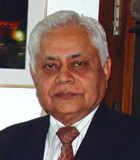INDIAN ARMED FORCES CHIEFS ON OUR RELENTLESS AND FOCUSED PUBLISHING EFFORTS

The insightful articles, inspiring narrations and analytical perspectives presented by the Editorial Team, establish an alluring connect with the reader. My compliments and best wishes to SP Guide Publications.

"Over the past 60 years, the growth of SP Guide Publications has mirrored the rising stature of Indian Navy. Its well-researched and informative magazines on Defence and Aerospace sector have served to shape an educated opinion of our military personnel, policy makers and the public alike. I wish SP's Publication team continued success, fair winds and following seas in all future endeavour!"

Since, its inception in 1964, SP Guide Publications has consistently demonstrated commitment to high-quality journalism in the aerospace and defence sectors, earning a well-deserved reputation as Asia's largest media house in this domain. I wish SP Guide Publications continued success in its pursuit of excellence.
Need for a full-time Minister of Defence
While the appointment of Manohar Parrikar as the Goa Chief Minister has been dictated by political expediency, this move has implications for the Indian armed forces
 | By Air Marshal B.K. Pandey (Retd) Former Air Officer Commanding-in-Chief of Training Command, IAF |
While the nation was coming to terms with the somewhat stunning but not entirely unexpected results of the elections in five states, the Indian armed forces are yet to appreciate the repercussions of the change in the political leadership as Minister of Defence, Manohar Parrikar, moved to Goa to don the mantle of the Chief Minister, a position he had held before moving to Delhi in 2015. He has now been replaced by Arun Jaitley, the Minister of Finance, who is holding the post of Minister of Defence as ‘Additional Charge’.

Defence, Dr Subhash Bhamre on March 14, 2017
While the appointment of Parrikar as the Chief Minister of Goa at this juncture has been dictated by considerations of political expediency for the party in power, this somewhat sudden move has implications for the Ministry of Defence (MoD) and in turn for the Indian armed forces. After a decade of deep slumber, in 2015, the Ministry of Defence under the NDA government with Manohar Parrikar as the Minister of Defence, embarked upon a number of reforms in the defence sector. At the outset, the NDA government is looking to turn the Indian Army into one of the finest fighting forces in the world with infrastructure and manpower to match rhetoric with action and cope with the emerging challenges. The Shekatkhar Committee report on the major reforms required has been submitted to the MoD and its recommendations are yet to be implemented.
While Parrikar had unveiled the restructured Defence Procurement Procedure (DPP) at the Defexpo in Goa in 2016, the document did not contain the chapter on Strategic Partnership with the private sector for the indigenous production of military hardware. This component of the DPP 2016 which Parrikar had promised to include at a later date, continues to remain as an unfinished agenda. This is a critical requirement in the context of the ‘Make in India’ programme of the NDA government as without it, indigenous production in the regime of aerospace and defence will not gather any momentum. Inclusion of this chapter has acquired urgency especially with major programmes for the manufacture in India with foreign collaboration of combat platforms such as the Lockheed Martin F-16 fighting Falcon or the Gripen JAS 39E from Saab of Sweden for the Indian Air Force (IAF) and possibly Boeing F/A-18 Super Hornet for the Indian Navy.
Another major task on his agenda was to introduce reforms in the regime of higher defence management through the creation of the post of Chief of Defence Staff (CDS) of the Indian armed forces. This was recommended in 2001 by a Group of Ministers set up in 2000 to review the management of the national security system in the aftermath of the Kargil War in 1999. The proposal to appoint a CDS that was crafted to bring about better organisational coordination and integration of the three wings of the Indian armed forces has been pending for the last 16 years. Parrikar was planning to see this proposal through in the next few months. Linked with this proposal also are plans to bring about significant organisational changes through the establishment of Theatre Commands, a concept that appears to be in a nascent stage.
But perhaps the most urgent task before Parrikar was to address the glaring shortages of weapons, ammunition and other items of military hardware the Indian Army is currently facing. The situation in the IAF with regard to the strength of its combat fleet is even more distressing as the number of squadrons equipped with fighter aircraft has dwindled to 32 as against the authorised level of 39.5 and is destined to go down further. Parrikar was embarked on addressing the problem through foreign collaboration under the ‘Make in India’ programme as also by ramping up production of the light combat aircraft Tejas by the Hindustan Aeronautics Limited from the present capacity of eight platforms per year to 16.
Clearly, keeping the nation secure is an onerous responsibility that the Minister of Defence must carry. This task is undoubtedly humongous and will require total and dedicated involvement of the political leadership in its execution. It goes without saying that the aspirations of the nation are unlikely to be fulfilled with a ‘Part-Time Minister of Defence’ at the helm. Hopefully, the government will address this issue without any further delay.





